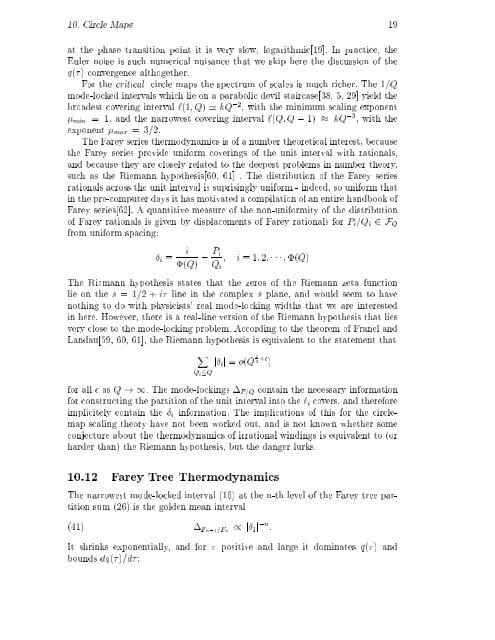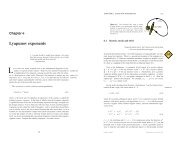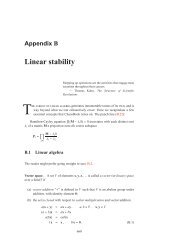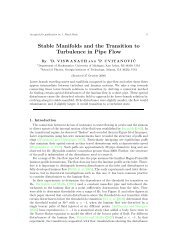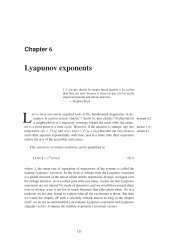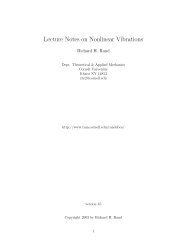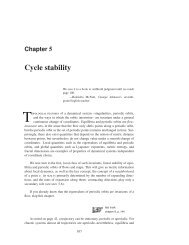10 Circle Maps: Irrationally Winding - Center for Nonlinear Science
10 Circle Maps: Irrationally Winding - Center for Nonlinear Science
10 Circle Maps: Irrationally Winding - Center for Nonlinear Science
Create successful ePaper yourself
Turn your PDF publications into a flip-book with our unique Google optimized e-Paper software.
<strong>10</strong>. <strong>Circle</strong> <strong>Maps</strong> 19<br />
at the phase transition point it is very slow, logarithmic[19]. In practice, the<br />
Euler noise is such numerical nuisance that we skip here the discussion of the<br />
q() convergence althogether.<br />
For the critical circle maps the spectrum of scales is much richer. The 1=Q<br />
mode-locked intervals which lie on a parabolic devil staircase[38, 5, 29] yield the<br />
broadest covering interval `(1Q) ' kQ ;2 , with the minimum scaling exponent<br />
min = 1: and the narrowest covering interval `(Q Q ; 1) kQ ;3 , with the<br />
exponent max = 3=2:<br />
The Farey series thermodynamics is of a number theoretical interest, because<br />
the Farey series provide uni<strong>for</strong>m coverings of the unit interval with rationals,<br />
and because they are closely related to the deepest problems in number theory,<br />
such as the Riemann hypothesis[60, 61] . The distribution of the Farey series<br />
rationals across the unit interval is suprisingly uni<strong>for</strong>m - indeed, so uni<strong>for</strong>m that<br />
in the pre-computer days it has motivated a compilation of an entire handbook of<br />
Farey series[62]. A quantitive measure of the non-uni<strong>for</strong>mity ofthe distribution<br />
of Farey rationals is given by displacements of Farey rationals <strong>for</strong> P i =Q i 2 F Q<br />
from uni<strong>for</strong>m spacing:<br />
i =<br />
i<br />
(Q) ; P i<br />
Q i<br />
<br />
i =1 2 (Q)<br />
The Riemann hypothesis states that the zeros of the Riemann zeta function<br />
lie on the s = 1=2 +i line in the complex s plane, and would seem to have<br />
nothing to do with physicists' real mode-locking widths that we are interested<br />
in here. However, there is a real-line version of the Riemann hypothesis that lies<br />
very close to the mode-locking problem. According to the theorem of Franel and<br />
Landau[59, 60, 61], the Riemann hypothesis is equivalent to the statement that<br />
X<br />
Q i Q<br />
j i j = o(Q 1 2 + )<br />
<strong>for</strong> all as Q !1. The mode-lockings P=Q contain the necessary in<strong>for</strong>mation<br />
<strong>for</strong> constructing the partition of the unit interval into the `i covers, and there<strong>for</strong>e<br />
implicitely contain the i in<strong>for</strong>mation. The implications of this <strong>for</strong> the circlemap<br />
scaling theory have not been worked out, and is not known whether some<br />
conjecture about the thermodynamics of irrational windings is equivalent to (or<br />
harder than) the Riemann hypothesis, but the danger lurks.<br />
<strong>10</strong>.12 Farey Tree Thermodynamics<br />
The narrowest mode-locked interval (16) at the n-th level of the Farey tree partition<br />
sum (26) is the golden mean interval<br />
(41)<br />
Fn;1=F n<br />
/ j 1 j ;n :<br />
It shrinks exponentially, and <strong>for</strong> positive and large it dominates q() and<br />
bounds dq()=d:


